Submitted:
03 September 2024
Posted:
03 September 2024
You are already at the latest version
Abstract
Keywords:
1. Introduction
- Evaluate the impact of controlled wetting and drying cycles on the soil's water characteristics curve and saturated hydraulic conductivity.
- Assess the impact of controlled wetting and drying cycles on the effective shear strength of soil.
- Perform a long-term stability analysis of a model flood embankment based on the hydromechanical properties of the soil measured above.
2. Materials and Methods
2.1. Materials
2.2. Samples Preparation
2.3. Application of Wetting and Drying Cycles
2.4. Measurement of Volumetric Change
2.5. Measurement of Saturated Hydraulic Conductivity (ksat)
2.6. Measurement of Soil Water Characteristic Curve (SWCC)
2.7. Measurement of Effective Shear Strength of Soil
2.8. Evaluating the Performance of Flood Embankment
3. Results
3.1. Volumetric Behaviour of Soils under Wetting and Drying Cycles
3.2. Hydraulic Characteristics of Soils under Wetting and Drying Cycles
3.3. Shear Strength of Soil under Wetting and Drying Cycles
3.4. Performance of Model Flood Embankment under Wetting and Drying Cycles
4. Discussion
5. Conclusions
Author Contributions
Funding
Institutional Review Board Statement
Informed Consent Statement
Data Availability Statement
Acknowledgements
Conflicts of Interest
References
- Clarke D, Smethurst JA. Effects of climate change on wetting and drying cycles in engineered clay slopes in England. Q J Eng. Geol. Hydrogeology, 2010;43:473–86. https://doi.org/10.1144/1470-9236/08-106. [CrossRef]
- Tang, C.S., Wang, D.Y., Shi, B. and Li, J., 2016. Effect of wetting–drying cycles on profile mechanical behaviour of soils with different initial conditions. Catena, 139, pp.105-116.
- Turrakheil, K.S., Shah, S.S.A. and Naveed, M., 2024. Evolution of Soil Pore Structure and Shear Strength Deterioration of Compacted Soil under Controlled Wetting and Drying Cycles. Atmosphere, 15, 843. https://doi.org/10.3390/ atmos15070843. [CrossRef]
- Xu, B., Yin, Z., et al. 2011 Experimental study of the factors and laws affecting the strength of expansive soil. Rock and Soil Mechanics, 32(1), pp. 44-50.
- Li, X.Y., Hu, H.B. and Guo, W., 2014. Dry-wet circulation intensity attenuation law of subgrade under the condition of clay. Highway Engineer, 164(1), pp.150-152.
- Xu, J., Zhou, L., Hu, K., Li, Y., Zhou, X. and Wang, S., 2022. Influence of wet-dry cycles on uniaxial compression behaviour of fissured loess disturbed by vibratory loads. KSCE Journal of Civil Engineering, 26(5), pp.2139-2152.
- Niu, Z.L., Xu, J., Li, Y.F., Wang, Z.F. and Wang, B., 2022. Strength deterioration mechanism of bentonite modified loess after wetting–drying cycles. Scientific Reports, 12(1), p.3130. [CrossRef]
- Khan, M.A., Hossain, M.S., Khan, M.S., Samir, S. and Aramoon, A., 2017. Impact of wet-dry cycles on the shear strength of high plastic clay based on direct shear testing. In Geotechnical Frontiers 2017 (pp. 615-622).
- Zhang, J.R., Xu, Q. and Sun, D.A., 2014. Simulation of soil-water characteristic curves during drying and wetting cycles. Rock and soil mechanics, 35(3), pp.689-695.
- Dyer, M., 2004, December. Performance of flood embankments in England and Wales. In Proceedings of the Institution of Civil Engineers-Water Management (Vol. 157, No. 4, pp. 177-186). Thomas Telford Ltd.
- Gowthaman, S.; Nakashima, K.; Kawasaki, S. Effect of wetting and drying cycles on the durability of biocemented soil of expressway slope. Int. J. Environ. Sci. Technol., 2022, 19, 2309–2322. [CrossRef]
- Rasul, J.M., Ghataora, G.S. and Burrow, M.P., 2018. The effect of wetting and drying on the performance of stabilised subgrade soils. Transportation Geotechnics, 14, pp.1-7.
- Stirling, R.A., Toll, D.G., Glendinning, S., Helm, P.R., Yildiz, A., Hughes, P.N. and Asquith, J.D., 2021. Weather-driven deterioration processes affecting the performance of embankment slopes. Géotechnique, 71(11), pp.957-969. [CrossRef]
- Tu, Y.; Zhang, R.; Zhong, Z.; Chai, H. The strength behavior and desiccation crack development of silty clay subjected to wetting-drying cycles. Front. Earth Sci. 2022, 10, 852820. [CrossRef]
- Zhao, G.T., Han, Z., Zou, W.L. and Wang, X.Q., 2021. Evolution of mechanical behaviours of an expansive soil during drying-wetting, freeze-thaw, and drying-wetting-freeze–thaw cycles. Bulletin of Engineering Geology and the Environment, 80(10), pp.8109-8121. [CrossRef]
- Zhang, J., Hu, H., Peng, J., Zhang, Y. and Zhang, A. 2024. Enhanced understanding of subgrade soil hydraulic characteristics: Effects of wetting–drying cycles and stress states on subgrade water migration. Journal of Hydrology, 635, 131165. https://doi.org/10.1016/j.jhydrol.2024.131165. [CrossRef]
- Ng, C. and Daniel, P. 2023. Pore structure effects on the water retention behaviour of a compacted silty sand soil subjected to drying-wetting cycles. Eng. Geol. 106963. https://doi.org/10.1016/j.enggeo.2022.106963. [CrossRef]
- Jing, J., Hou, J., Sun, W., Chen, G., Ma, Y. and Ji, G. 2022. Study on influencing factors of unsaturated loess slope stability under dry-wet cycle conditions. J. Hydrol. 612 (Part B), 128187. [CrossRef]
- Wen, T., Chen, X., Shao, L. 2022. Effect of multiple wetting and drying cycles on the macropore structure of granite residual soil. J. Hydrol. 614, 128583 https://doi.org/ 10.1016/j.jhydrol.2022.128583. [CrossRef]
- Chen, X., Quan, Q., Zhang, K. and Wei, J., 2021. Spatiotemporal characteristics and attribution of dry/wet conditions in the Weihe River Basin within a typical monsoon transition zone of East Asia over the recent 547 years. Environmental Modelling & Software, 143, p.105116. [CrossRef]
- Ventini, R., Dodaro, E., Pirone, M., Giretti, D., Gragnano, C.G., Fioravante, V., Gottardi, G. and Mancuso, C., 2023, June. Integrated Physical and Numerical Modelling to Study the Hydro-Mechanical Response of a River Embankment. In National Conference of the Researchers of Geotechnical Engineering (pp. 569-577). Cham: Springer Nature Switzerland.
- Zhao, Ya. (2022). The Influence of Rainfall and Evaporization Wetting-Drying Cycles on the Slope Stability. Advances in Meteorology. 2022. 1-8. 10.1155/2022/5775424.
- Hassan, M.A., Ismail, M.A.M. and Shaalan, H.H., 2022. Numerical modelling for the effect of soil type on stability of embankment. Civil Engineering Journal, 7, pp.41-57. [CrossRef]
- BS 1377-1: 2016 Methods of test for soils for civil engineering purposes – Part 1: General requirements and sample preparation.
- BS 1377-2: 2022; Methods of Test for Soils for Civil Engineering Purposes—Part 2: Classification Tests and Determination of Geotechnical Properties. The British Standards Institution: London, UK, 2016.
- BS 1377-4: 1990 Methods of test for soils for civil engineering purposes – Compaction related tests.
- BS 1377-6:1990 - Methods of test for soils for civil engineering purposes. Consolidation and permeability tests in hydraulic cells and with pore pressure measurement.
- ASTM Standard D5298-03, 2007, Standard Test Method for Measurement of Soil Potential (Suction) Using Filter Paper, Annual Book of ASTM Standards, Soil and Rock (I), 4(8), ASTM International, West Conshohocken, PA.
- Chandler, R.J., Crilly, M.S., Montgomery-Smith, G. 1992. A low-cost method of assessing clay desiccation for low-rise-buildings. Proc Inst Civil Eng. 92, 82-9. [CrossRef]
- Van Genuchten, M. Th. 1980. A closed-form equation for predicting the hydraulic conductivity of unsaturated soils. Soil Sci. Soc. Am. J. 44: 892–898. [CrossRef]
- Shah, Syed Samran Ali, Abdul Rahim Asif, Waqas Ahmed, Ihtisham Islam, Muhammad Waseem, Hammad Tariq Janjuhah, and George Kontakiotis. 2023. "Determination of Dynamic Properties of Fine-Grained Soils at High Cyclic Strains" Geosciences 13, no. 7: 204. https://doi.org/10.3390/geosciences13070204. [CrossRef]
- Tang, C.-S., Cheng, Q., Gong, X., Shi, B. and Inyang, H.I. 2023. Investigation on microstructure evolution of clayey soils: A review focusing on wetting/drying process. J. Rock Mech. Geotech. Eng., 15, 269–284. [CrossRef]
- Ye, W.M., Wan, M., Chen, B., Cui, Y. and Wang, J. 2011. Micro-structural behaviors of densely compacted GMZ01 bentonite under drying/wetting cycles. Chin. J. Geotech. Eng., 33, 1173–1177.
- Cui, Y.J., Yahia-Aissa, M. and Delage, P.A. 2002. model for the volume change behavior of heavily compacted swelling clays. Eng. Geol., 64, 233–250. [CrossRef]
- Liu, Y. 2016. Investigation on the swelling properties and microstructure mechanism of compacted Gaomiaozi bentonite. J. Eng. Geol., 24, 451–458.
- Cuisinier, O., Auriol, J.C., Le Borgne, T. and Deneele, D. 2011. Microstructure and hydraulic conductivity of a compacted lime-treated soil. Eng. Geol., 123, 187–193. [CrossRef]
- Zhou, R., Wang, B., Han, S., Wang, D. and Zhang, F. 2024. Mechanisms of crack development and strength deterioration in compacted expansive soils under controlled wetting-drying conditions. Eng. Fail. Anal., 159, 108133. [CrossRef]
- Azizi, A., Musso, G. and Jommi, C. 2019. Effects of repeated hydraulic loads on microstructure and hydraulic behaviour of a compacted clayey silt. Can. Geotech. J. 57, No. 1, 100–114, https://doi.org/10.1139/cgj-2018-0505. [CrossRef]
- Alonso, E. E., Romero, E., Hoffmann, C. and García-Escudero, E. 2005. Expansive bentonite-sand mixtures in cyclic controlled suction drying and wetting. Eng. Geol. 81, No. 3, 213–226. [CrossRef]
- Liu, G., Toll, D. G., Kong, L. and Asquith, J. D. 2020. Matric suction and volume characteristics of compacted clay soil under drying and wetting cycles. Geotech. Test. J. 43, No. 2, 20170310. [CrossRef]
- Dixon, N., Crosby, C. J., Stirling, R., Hughes, P. N., Smethurst, J., Briggs, K., Hughes, D., Gunn, D., Hobbs, P., Loveridge, F., Glendinning, S., Dijkstra, T. & Hudson, A. 2019. In situ measurements of near-surface hydraulic conductivity in engineered clay slopes. Q. J. Eng Geol. Hydrogeol. 52, No. 1, 123–135. [CrossRef]
- Zhou, R.; Wang, B.; Han, S.; Wang, D.; Zhang, F. Mechanisms of crack development and strength deterioration in compacted expansive soils under controlled wetting-drying conditions. Eng. Fail. Anal. 2024, 159, 108133. [CrossRef]
- Zhu, R.; Cai, Z.; Huang, Y.; Zhang, C.; Guo, W.; Wang, Y. Effects of wetting-drying-freezing-thawing cycles on mechanical behaviours of expansive soil. Cold Reg. Sci. Technol. 2022, 193, 103422.
- Hafhouf, I. and Khelifa, 2023. A. Impact of drying-wetting cycles on shear properties, suction, and collapse of Sebkha soils. Heliyon, e13594. [CrossRef]
- Nahlawi, H. and Kodikara, J. 2006. Laboratory Experiments on Desiccation Cracking of Thin Soil Layers. Geotechnical and Geological Engineering, 24, 1641-1664. http://dx.doi.org/10.1007/s10706-005-4894-4. [CrossRef]
- Rahardjo, H., Leong, E.C., and Rezaur, R.B. 2004. Effect of antecedent rainfall on pore-water pressure distribution characteristics in residual soil slopes. Journal of Hydrology, 287(1-4), 24-42.
- Anderson, M.G., Hubbard, M.G. and Kneale, P.E. 1982. The influence of shrinkage cracks on pore-water pressures within a clay embankment. Q. J. Engng Geol. Hydrogeol. 15, No. 1, 9–14. [CrossRef]
- Dyer, M., Utili, S. and Zielinski, M. 2009. Field survey of desiccation fissuring of flood embankments. Proc. Instn Civ. Engrs – Wat. Manage. 162, No. 3, 221–232, https://doi.org/10.1680/wama. 2009.162.3.221.
- Ng, C.W.W., Zhan, L.T. and Bao, C.G., Fredlund, D.G. and Gong, B.W. 2003. Performance of an unsaturated expansive soil slope subjected to artificial rainfall infiltration. Géotechnique 53, No. 2, 143–157, https://doi.org/10.1680/geot. 53.2.143.37272. [CrossRef]
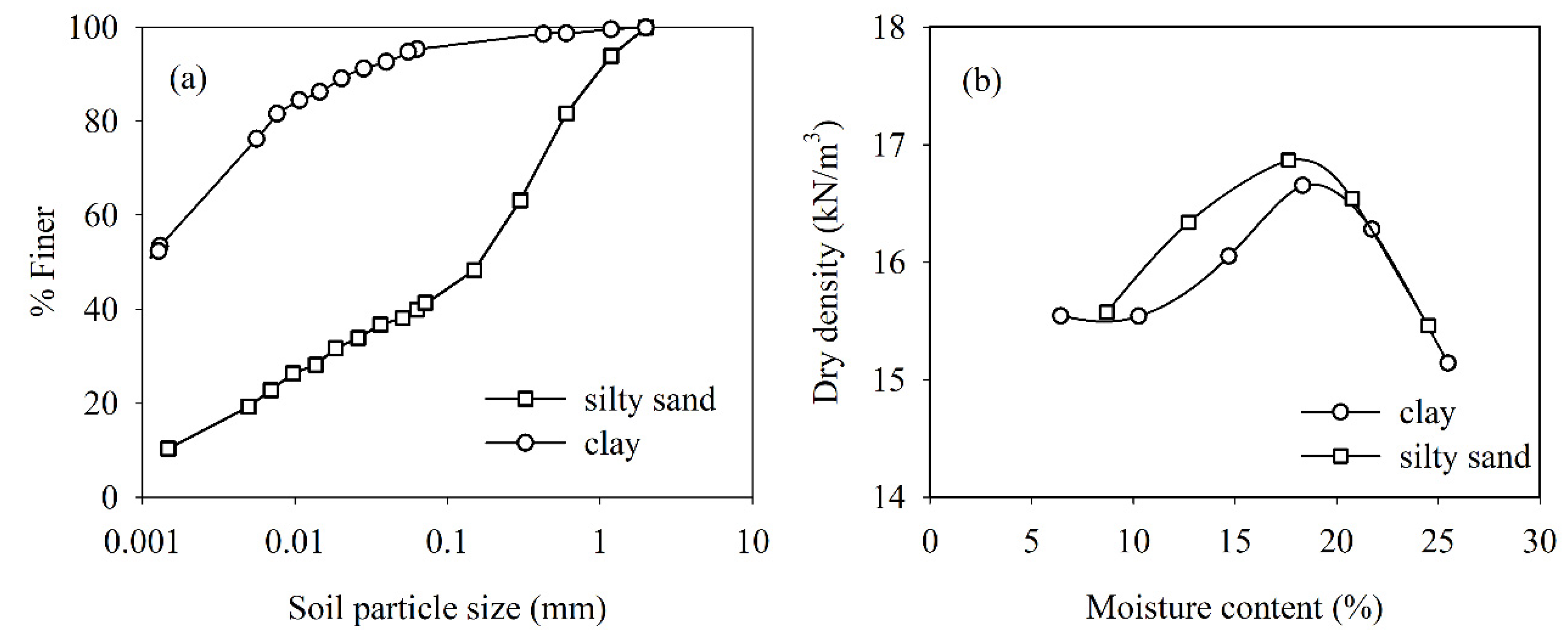
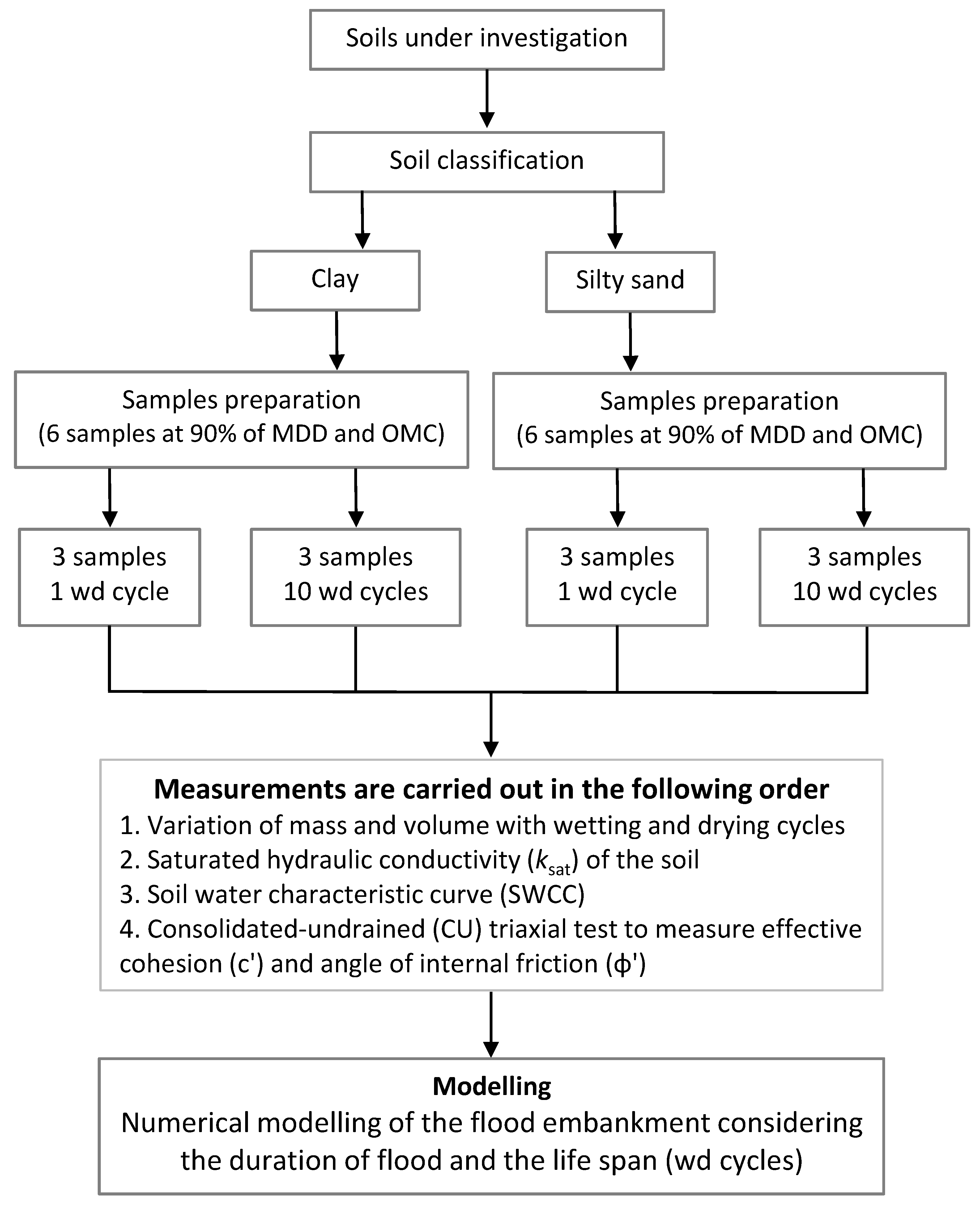
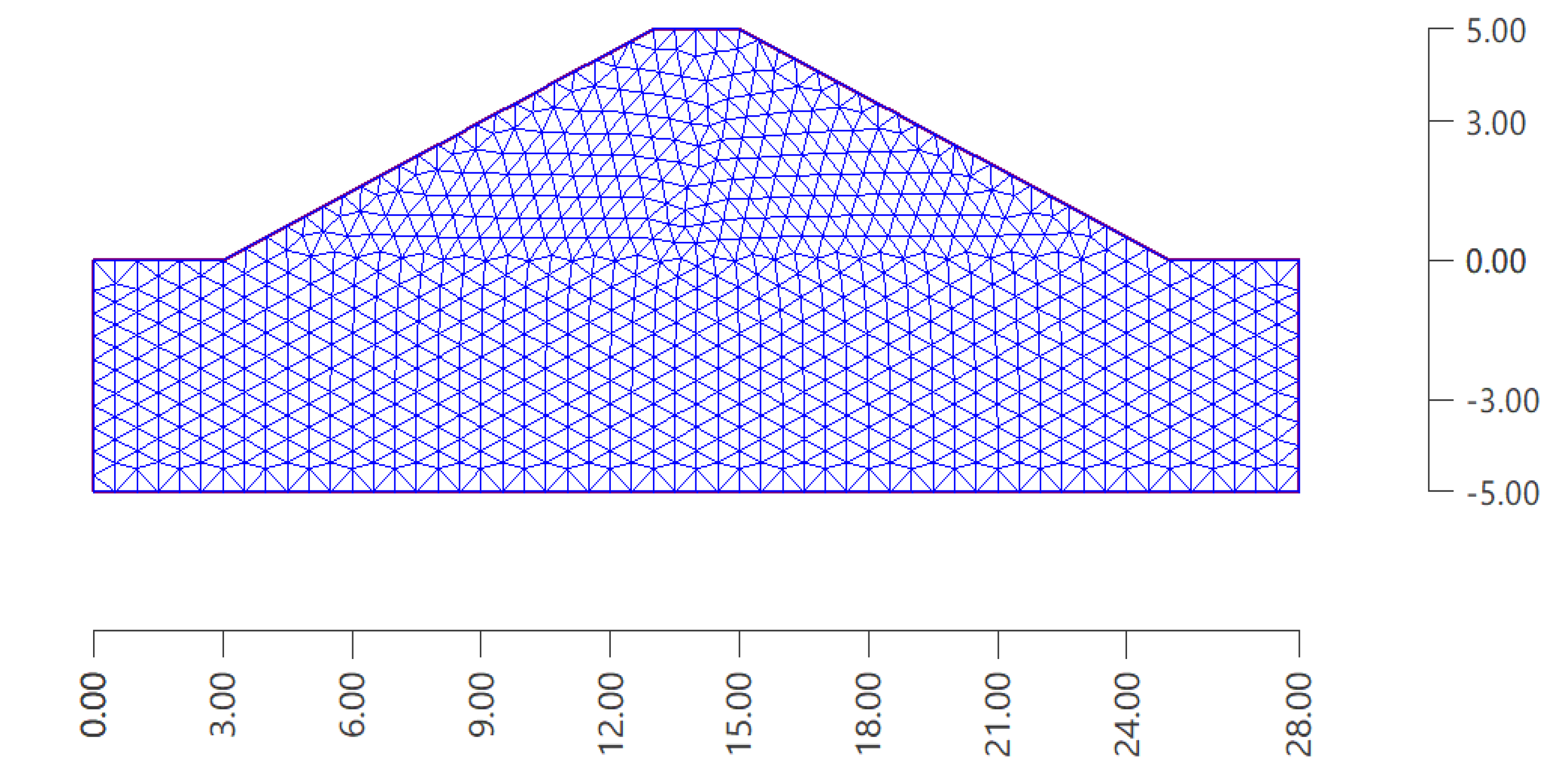
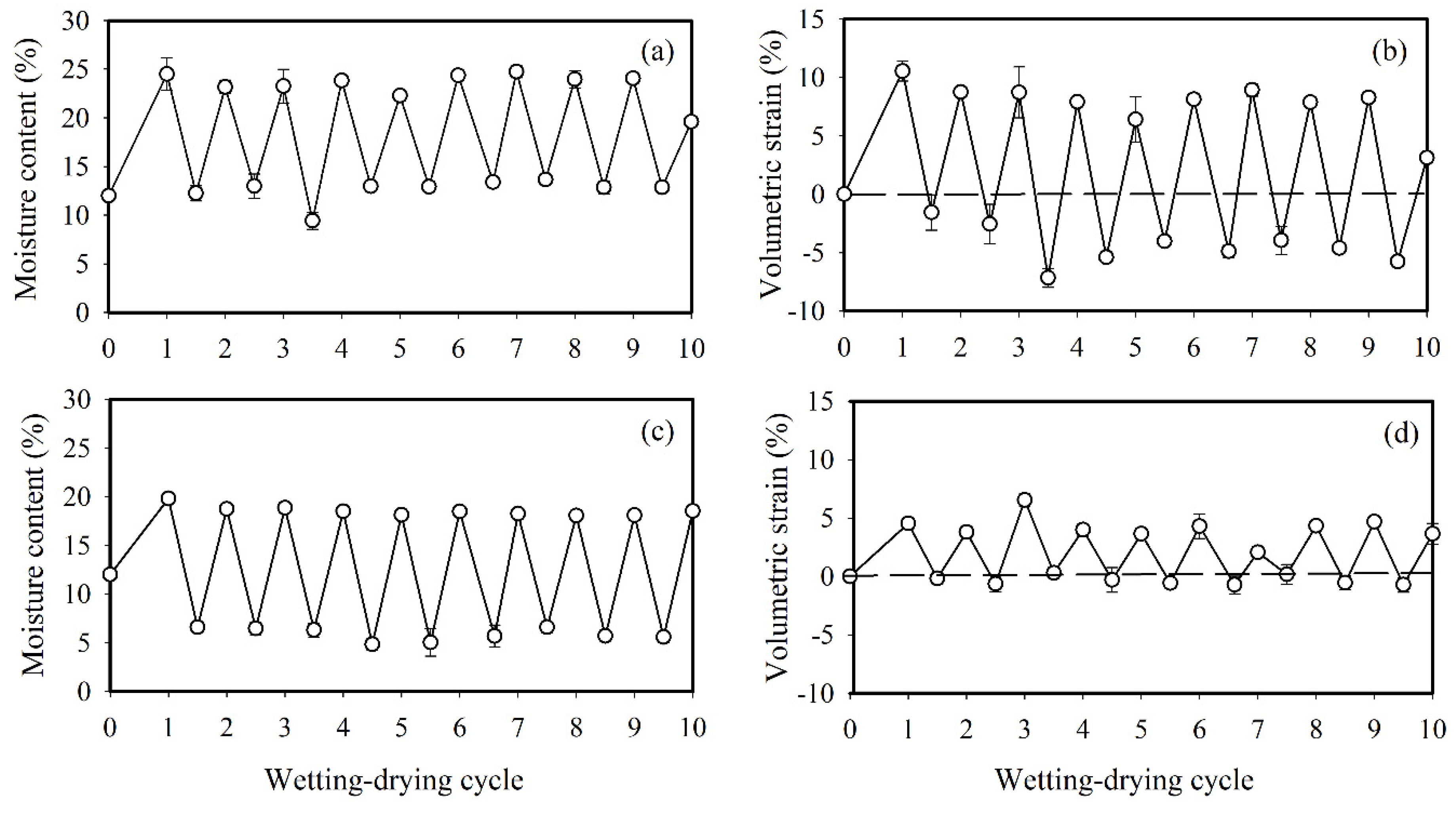
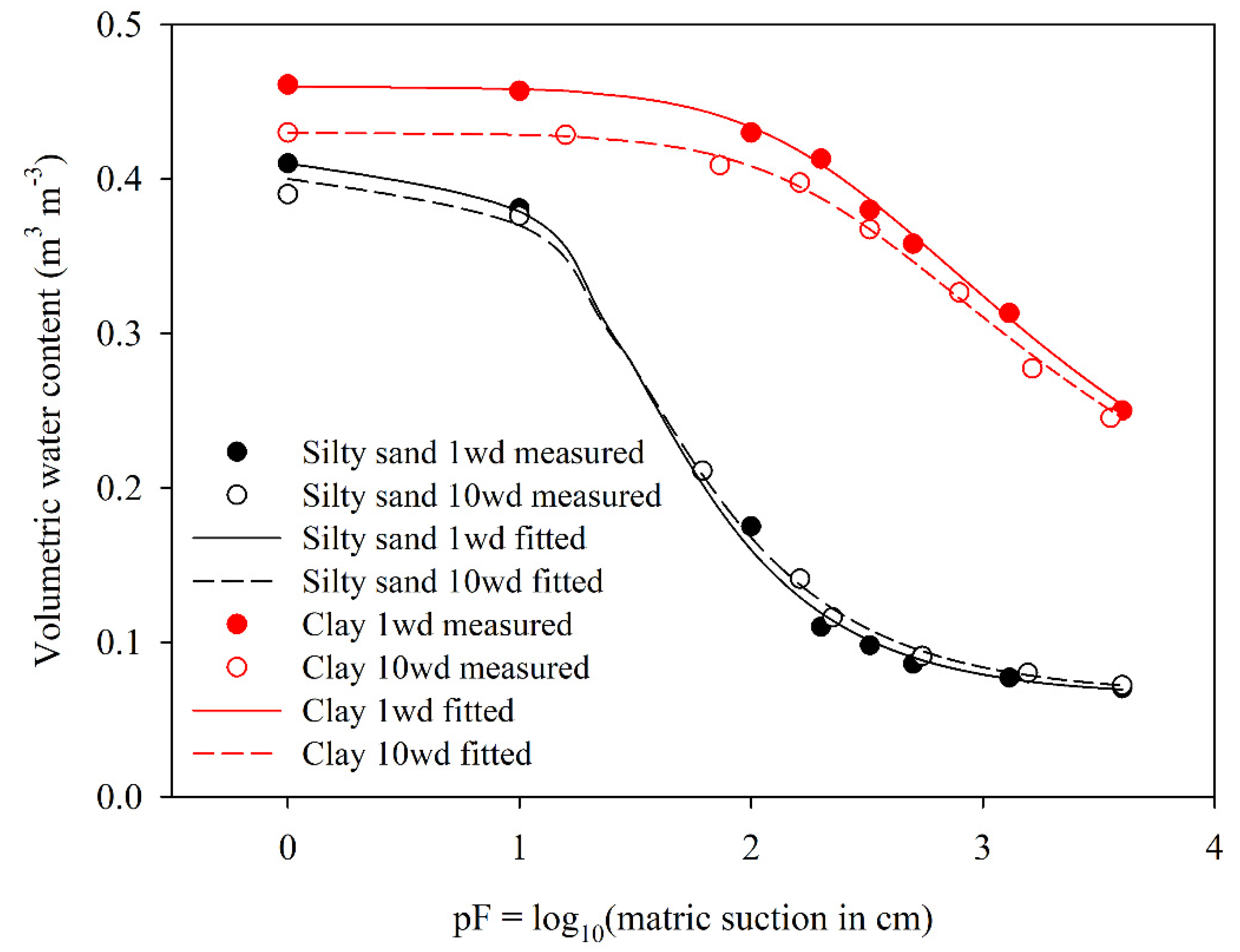
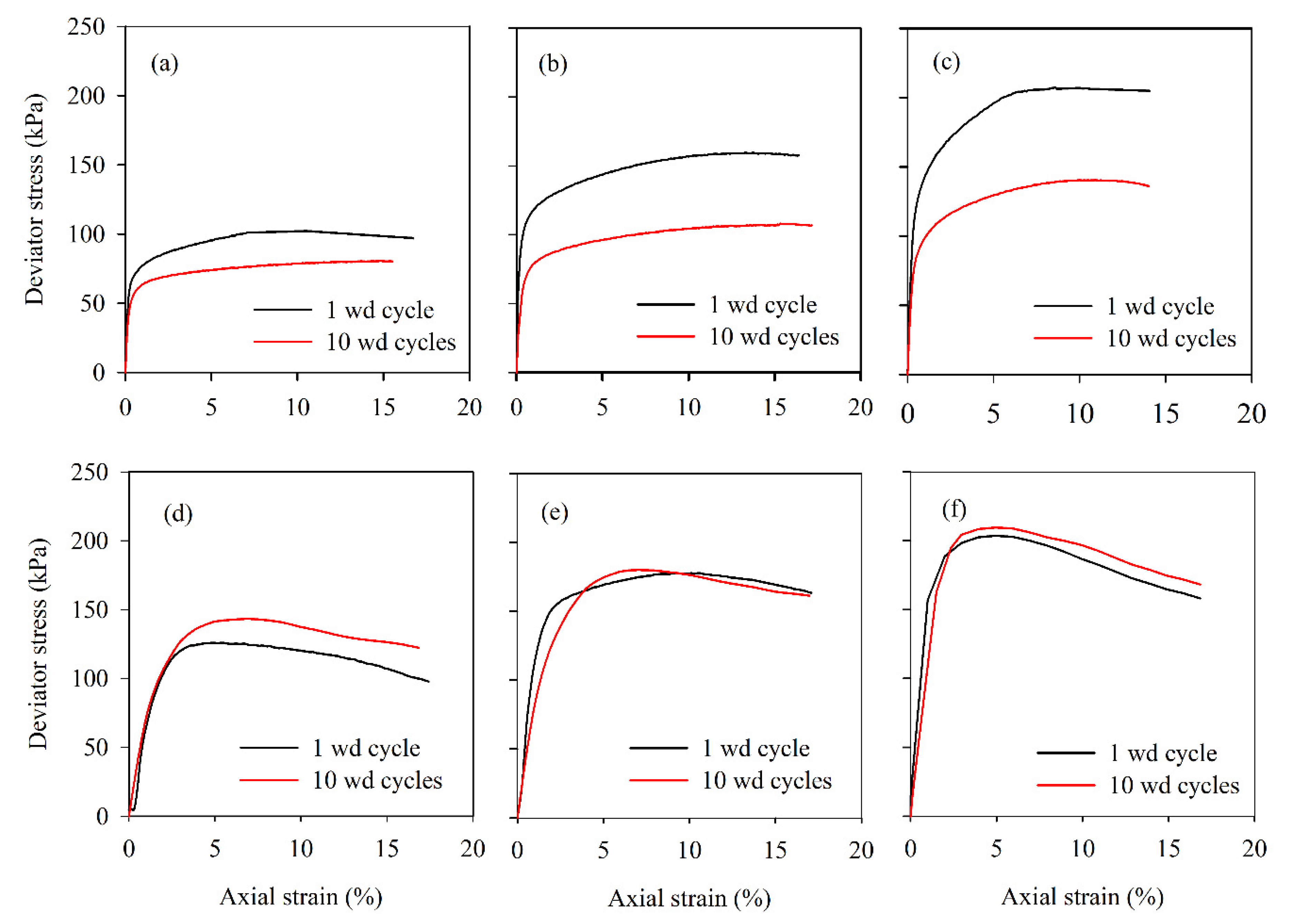
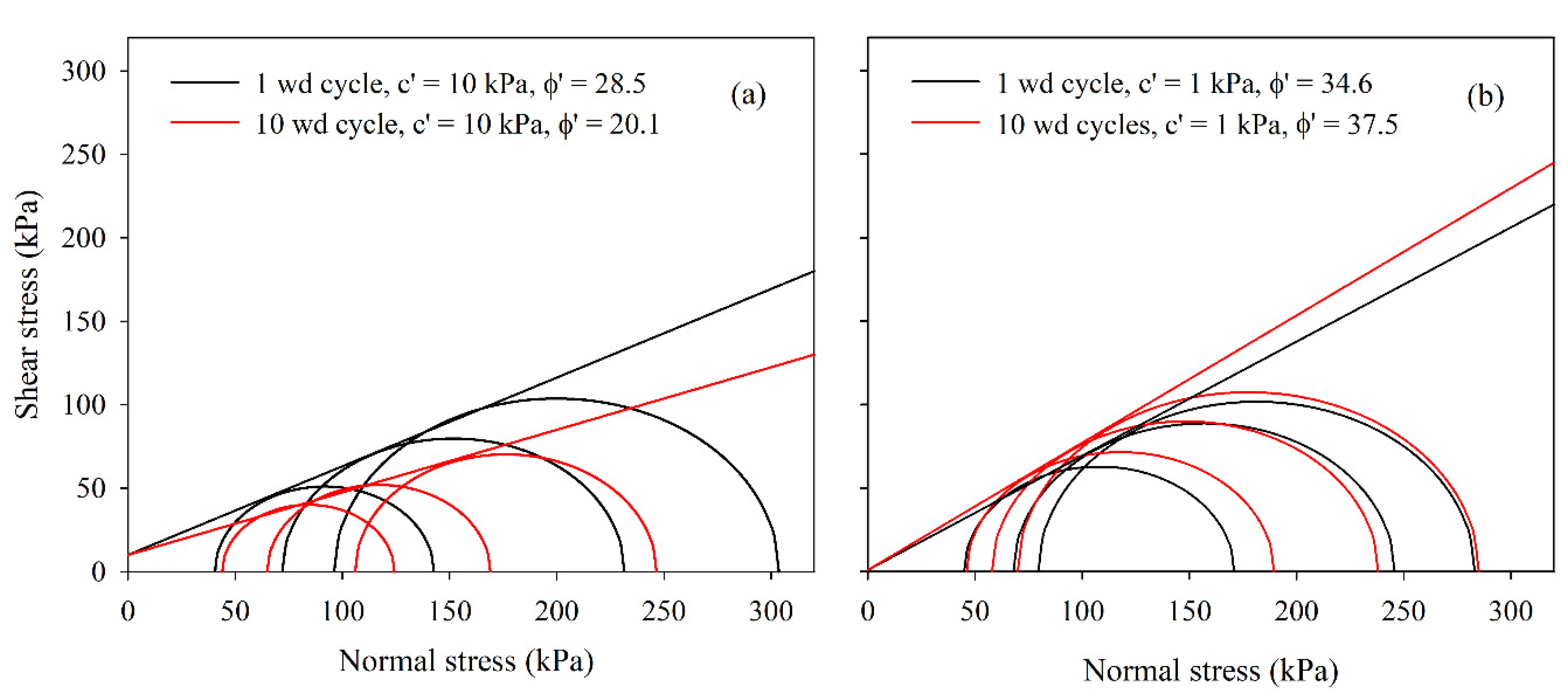
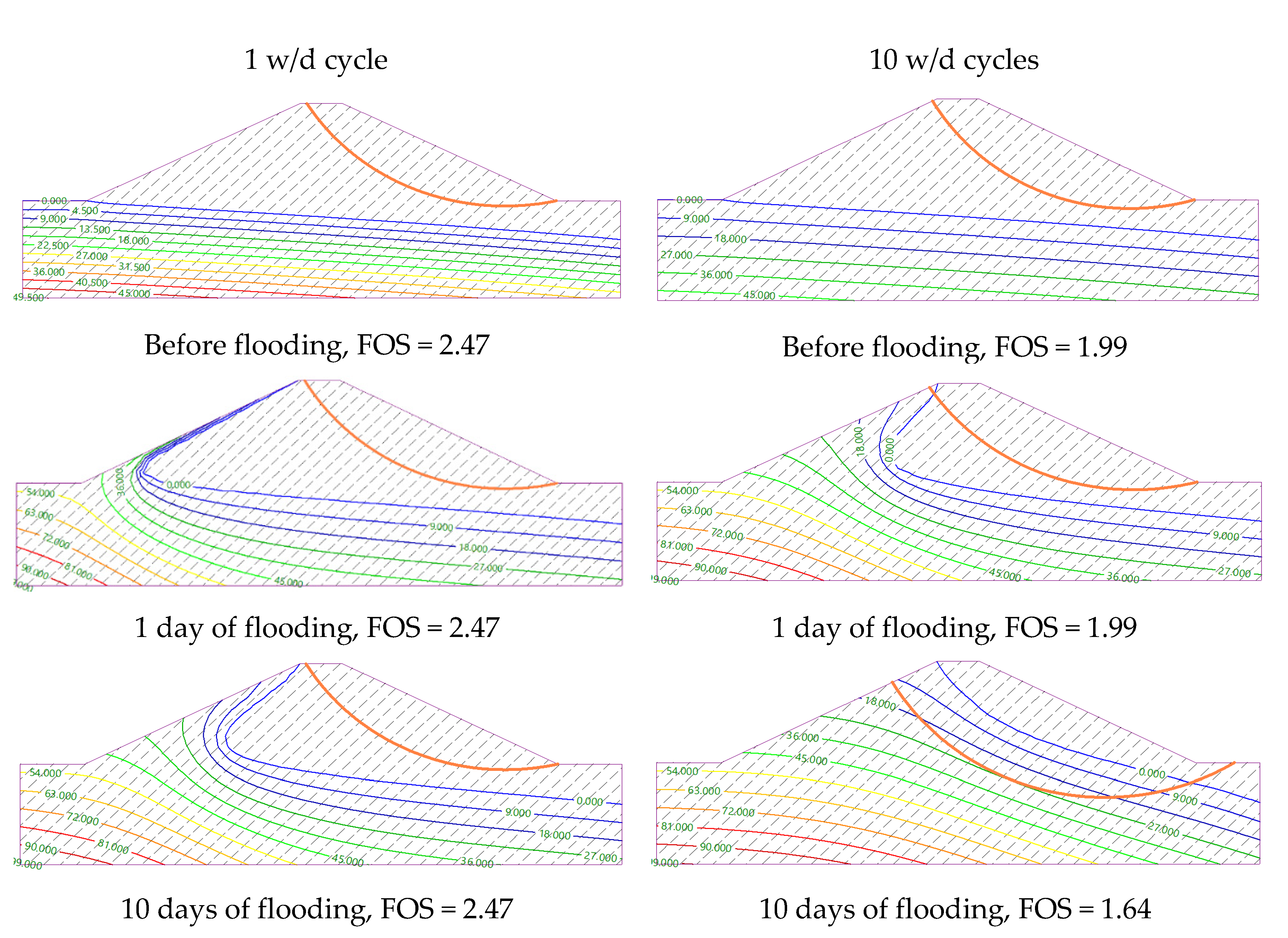
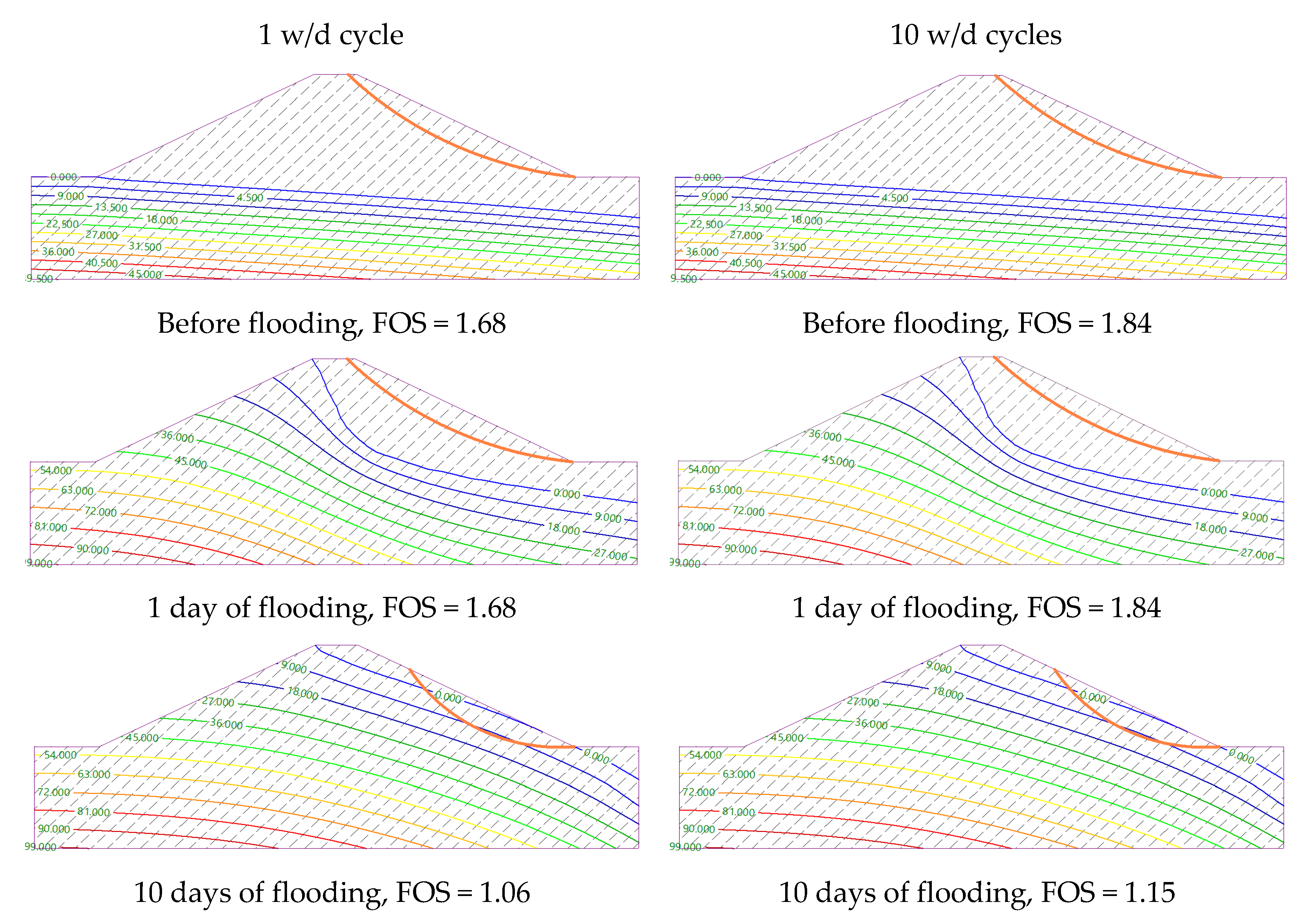
| Parameter | Clay | Silty sand | ||
| 1 wd cycle | 10 wd cycles | 1 wd cycle | 10 wd cycles | |
| dry density (kN/m3) | 16.2 | 16.2 | 16 | 16 |
| saturated density (kN/m3) | 18.5 | 18.5 | 18 | 18 |
| initial void ratio (-) | 0.67 | 0.67 | 0.66 | 0.65 |
| effective angle of internal friction (deg) | 28.5 | 20.1 | 34.6 | 37.5 |
| effective cohesion (kN/m2) | 10 | 10 | 1 | 1 |
| saturated hydraulic conductivity (m/d) | 0.0051 | 0.0331 | 1.061 | 1.032 |
| van Genuchten parameter, α (1/m) | 0.5 | 0.45 | 4.5 | 4.5 |
| van Genuchten parameter, n (-) | 1.25 | 1.19 | 1.84 | 1.77 |
| saturated moisture content (m3/m3) | 0.46 | 0.43 | 0.41 | 0.40 |
Disclaimer/Publisher’s Note: The statements, opinions and data contained in all publications are solely those of the individual author(s) and contributor(s) and not of MDPI and/or the editor(s). MDPI and/or the editor(s) disclaim responsibility for any injury to people or property resulting from any ideas, methods, instructions or products referred to in the content. |
© 2024 by the authors. Licensee MDPI, Basel, Switzerland. This article is an open access article distributed under the terms and conditions of the Creative Commons Attribution (CC BY) license (http://creativecommons.org/licenses/by/4.0/).





